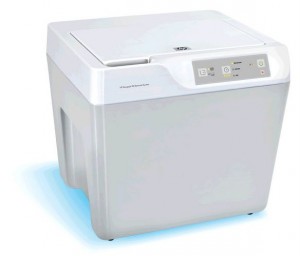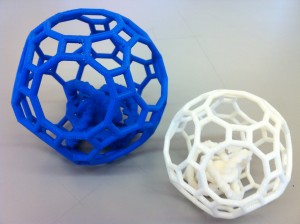Promotional Videos
Author Archives: Rebecca
Wash Day
As we’ve discovered, 3D printing opens up a new world of possibilities in terms of seamlessly printed and pre-assembled objects. We can create working hinges and joints, objects within objects, and complex designs that before had to be individually created and then put together.
Unfortunately, a lot of these complex pieces cannot be used right out of the printer– they need to go into a special washing machine, aka the Support Removal System, that dissolves the support material necessary to make that piece.
Our washing machine lives in the boys’ bathroom, one floor below our project area. Luckily the bathroom has been turned into a storage closet, so the only other people who have access to it are the building janitors. We had several issues hooking up the SRS, since it was a prototype and didn’t exactly match the washer in the manual HP provided. One of the biggest issues was that it didn’t really work. We would put things in and 6 hours later they would have just as much support material as before. After several days of trouble-shooting and exchanging emails with the support team at HP, we decided that there was something wrong with the washer, and not necessarily with the way we were trying to use it. So last week we got a new washer, that actually looks like the picture above! And best news of all… it works! These are some of our creations that really didn’t work without the help of a functional washer:
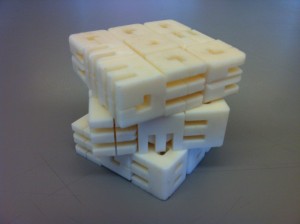
- Letter-based Rubix Cube (designed by qijie on Thingaverse)
Even when the washing machine works, it still takes a decent amount of time (between 3 and 12 hours) to dissolve all of the support material. So, after learning how hindering the washing process can be, we are looking into different printing methods that don’t depend as much upon layers and layers of support material. How can we minimize production time– from the time we press print to the time when our object is ready to use?
Look What’s Cooking
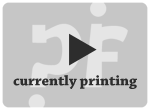 Take a look at what we’ve got running in the printer!
Take a look at what we’ve got running in the printer!
We finally got a crossover cable so that we can hook our dedicated computer and get some of our own .stl files printed! We ran a few default test files to be sure the machine worked, was calibrated, etc, but here’s the first experiments with uploading content of our own creation. Look familiar?
Update: If you want to skip the process, you can go ahead and see the finished product! It printed beautifully, and was the easiest of all the prints so far to remove from the support material base. There were no hangups with our file creation, and even with the interface in Spanish, Matt was able to get it going quickly and easily. Now for something a little more complex, as we continue exploring the magic of additive manufacturing!
Link Round-up
We’ve been laying a lot of groundwork for our project this week, developing some tech and focusing in on what our deliverables are going to be. In this stage of our process, we’re not certain what is covered by our NDA, but we can share some interesting 3D printing-related links that we’ve found!
There are a few amazing browser-based 3D modeling programs out there, and a few more in the works. Made to be easy, simple and extremely accessible, they fall along a spectrum of usefulness and approachability.
3DTin, the first such program, is fairly robust but has some serious flaws in usability. I, personally, find the user interface far more confusing and difficult than helpful, but it does allow for a fairly wide range of options, including color data in .stl files. Selecting, modifying and deleting objects can become a futile and frustrating exercise in random pointing-and-clicking, but with a more robust existing knowledge of 3D modeling software, it may be less of an issue. Using voxels, on the other hand, and drawing as if with LEGOs, is pretty simple. Uploading to i.materialize and Thingiverse is a simple affair, and it’s been used for some TEDxKids workshops with some awesome results. 3DTin requires that all objects made with the interface enter Creative Commons.
Tinkercad, on the other hand, is far more simplistic but also much more friendly. It is intended specifically for printed output. The “wood-look” of the pieces you manipulate speaks directly to a hardness as well as a scale, and makes the actions of subtractive modeling more clear, as an analogy to carving into the wood. The extremely helpful @craftyb told me about her 8-year-old son designing and modeling creations with the tools, after learning the basics through the “Quests” or short tutorials the website provides. This video from a Maker Faire demonstrates how easy it is to get started with simple modeling processes. It also allows easy sharing with Thingiverse. Tinkercad does require an account, and saves all user-generated projects in an easy-to-access dropdown.
Shapesmith is another up-and-coming browser-based modeling platform which, while still in progress, promises to be quite exciting. While the distinctly Matrix-looking interface is more confusing and less inviting than the previous two, the placement system seems more robust. After selecting a primitive type, the user clicks to select the placement along the x-coordinate plane, then drags the cursor for a real-time view of the width and height of the object, rather than being required to specify all dimensions before placing it in the work area. Since Shapesmith is created with the goal of exporting to STL, once it’s fully fleshed out, it should be amazing.
As an added bonus, I’m also excited to check out Waybe, a plug-in for Google SketchUp that translates 3D designs into printable pages that can be cut, folded and assembled for paper-based models. Since several of us have papercraft projects in the works (or sitting on the back burner) this might be an interesting way to help us think about the translation between different digital and physical forms, and the process of creating or assembling those forms.
Houston, We Have a Printer!
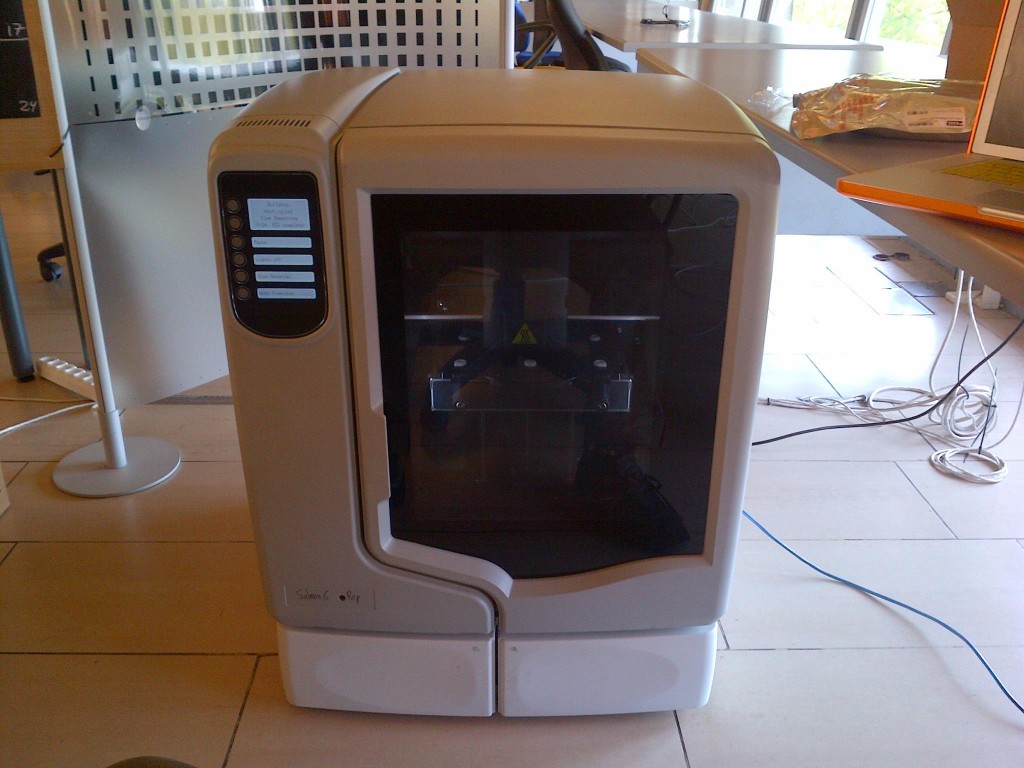
 The printer has officially arrived at the Media Dome!! It was accompanied by a support removal system (aka “the washing machine”), some consumables to test with and lots and lots of excitement.
The printer has officially arrived at the Media Dome!! It was accompanied by a support removal system (aka “the washing machine”), some consumables to test with and lots and lots of excitement.
We´ve found a water closet — literally — for the SRS to live in, and the printer has found a home next to our desks. It makes a comforting kind of hum when working, though it´s mostly drowned out by the air conditioning. It rattled off a test calibration print, which was successful, and the local connection is being set up so that we can get testing with something a bit more exciting…. Expect plenty more photos soon!
Life in the Media Dome
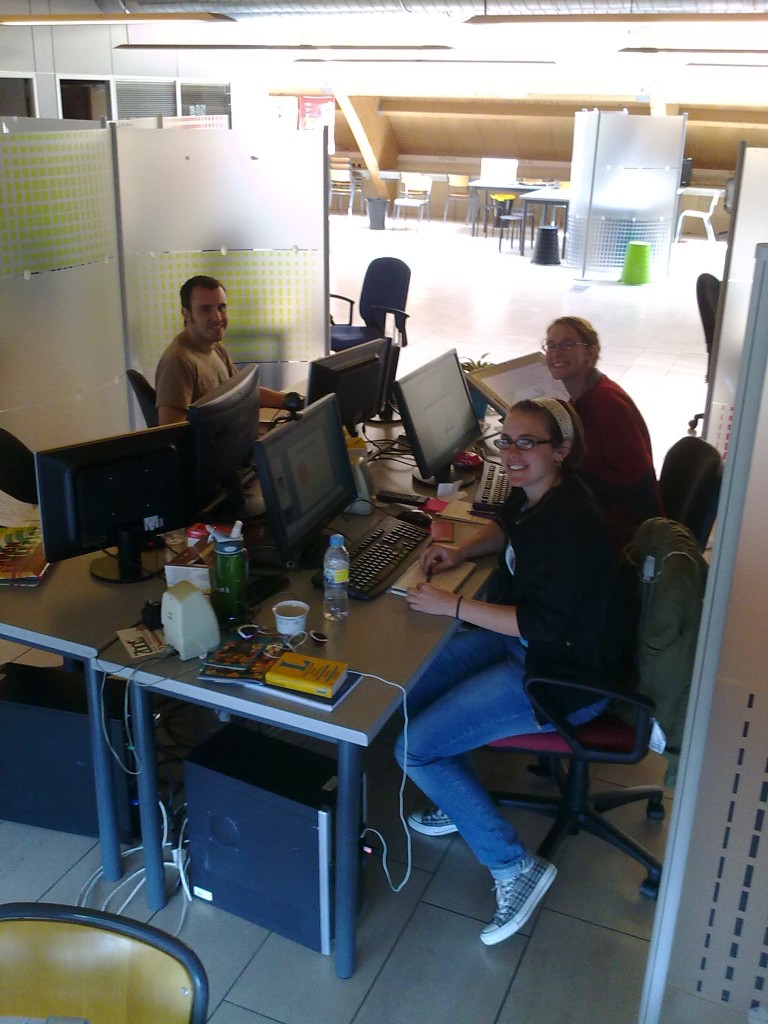 We´re mostly set up here in the Media Dome at La Salle University! As you can tell, it´s a pretty open floor plan, with thin, movable walls to section off spaces. Classes for the Masters students here don´t begin until the second week of October, though, so it´s been fairly quiet.
We´re mostly set up here in the Media Dome at La Salle University! As you can tell, it´s a pretty open floor plan, with thin, movable walls to section off spaces. Classes for the Masters students here don´t begin until the second week of October, though, so it´s been fairly quiet.
We´re working on growing a forest of monitors and cables, plus an actual (if somewhat sad) potted fern. We managed to find a portion of a Heinz 57 Ketchup poster in a recycling pile at HP during our last visit and we were allowed to take it with us, for a little bit of hometown, Pittsburgh-style decoration.
Matt, Dani and Rebecca. Not pictured: David. Photo by our advisor, Oscar García Pañella.
